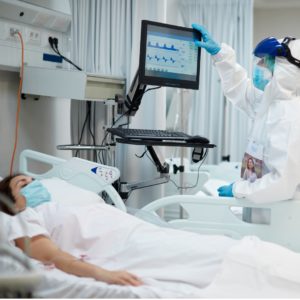Interventional Care


We notice that you are visiting us from . This site only services US-based visitors. Would you like to visit the site that is appropriate for your location?

Inactivation of Candida auris and Candida albicans by ultraviolet-C. authored by Rutala WA, Kanamori H, Gergen MF, Sickbert-Bennett EE, Weber DJ1 addresses the ability of UV-C to inactivate C. auris.
Candida auris is an emerging fungal pathogen that is often resistant to major classes of antifungal drugs. It is a serious global health threat and has caused severe infections with frequent mortality in many countries. C. auris can survive on healthcare environmental surfaces for at least 7 days and cause outbreaks in healthcare facilities. These findings suggest that C. auris has an environmental route of transmission. Thus, infection prevention strategies, such as surface disinfection and room decontamination technologies (e.g., ultraviolet-C) , are essential to control transmission. In this study, a UV-C device (Tru-D SmartUVC, LLC. Memphis, TN) was evaluated for its antimicrobial activity against C. auris and C. albicans.1
There is no standard level of germicidal efficacy for environmental surfaces, but a log10 reduction of at least 3-log10 (or 99.9% reduction) is likely to be clinically effective against C. auris in preventing environmental transmission. The UV-C room decontamination unit tested achieved an overall 2.93-log10 reduction of C. auris (Antibiotic Resistance Bank #0385 strain) with fetal calf serum (FCS) and an overall 2.48-log10 reduction of C. auris without FCS. C. auris had a lower log10 reduction than C. albicans. Direct UV-C, with or without FCS (log10 reduction 4.57 and 4.45, respectively), had a higher log10 reduction than indirect UV-C for C. auris (log10 reduction 2.41 and 1.96, respectively), which was statistically significant. The vertical UV-C (i.e., perpendicular to UV light) had statistically higher log10 reductions than horizontal UV (i.e., flat on surface) against C. auris and C. albicans with FCS and without FCS. For example, for C. auris with FCS the log10 reductions for vertical surfaces were 4.92 and for horizontal surfaces, the log10 reductions were 2.87.
This study and other studies2 demonstrated that C. auris can be inactivated on environmental surfaces so long as factors that affect inactivation are optimized (e.g., exposure time, distance, UV-C intensity). In our investigation, the UV-C device was set on the bacterial cycle (12,000 µWs/cm2) and the device operated for 17-19 minutes. Cadnum and associates2 suggested that longer cycles (i.e., sporicidal) may be beneficial, as has been recommended for some UV-C devices in C. difficile contaminated rooms. These data and other published UV-C studies should be used in developing cycle parameters that prevent contaminated surfaces from being a source of acquisition by staff or patients of this globally emerging pathogen.
Disclosure: Dr. Rutala is a consultant for PDI.
1Rutala WA, Kanamori K, Gergen MF, Sickbert-Bennett EE, Weber DJ. 2021 Inactivation of Candida auris and Candida albicans by ultraviolet-C. Infect Control Hosp Epidemiol.doi: https://doi.org/10.1017/ice.2021.214
2Cadnum JL, Shaikh AA, Piedrahita CT, Jencson AL, Larkin EL, Ghannoum MA, et al. Relative resistance of the emerging fungal pathogen Candida auris and other Candida species to killing by ultraviolet light. Infect Control Hosp Epidemiol 2018;39:94-96. doi: 10.1017/ice.2017.239. Epub 2017 Nov 21.